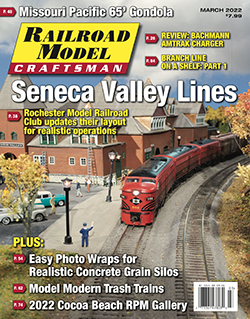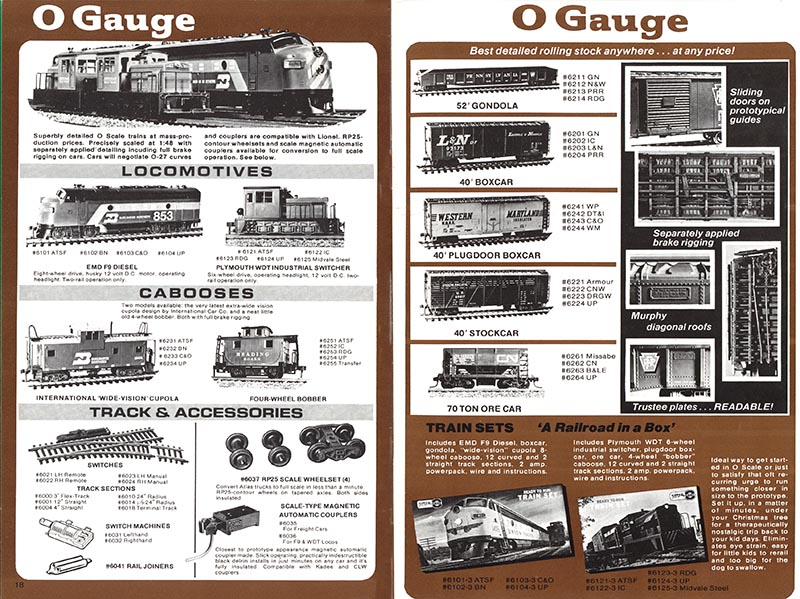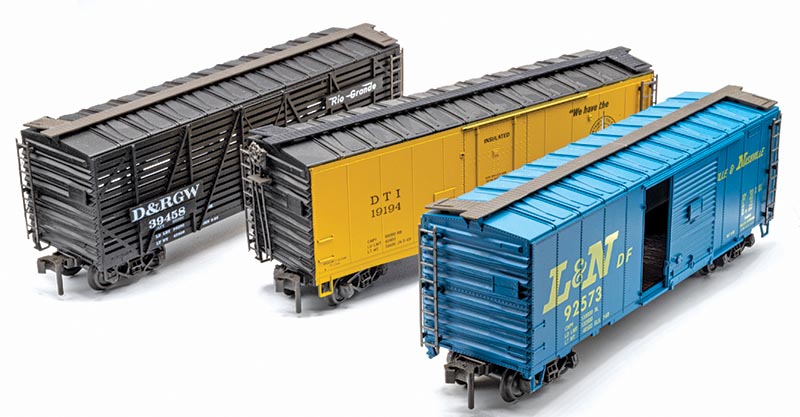 Tony Cook and James DeBruin/photos as noted
Tony Cook and James DeBruin/photos as noted
In covering the annual 1971 Hobby Industry Association of America trade show, Railroad Model Craftsman editor Tony Koester was among the first to see Atlas’ O scale products. Koester’s report in the May 1971 issue says, “Atlas surprised everyone with a brand new line of O scale.” On display at that event were early samples of an F9A diesel locomotive, gondola, stock car, and caboose. The rolling stock was decorated and appeared to be close to production samples, while the Electro-Motive Division (EMD) F9 is more of a mock-up of the coming Union Pacific offering with lettering and decoration that differs from what came later. Koester noted the reproductions are accurate 1/4-inch scale with couplers and wheels that could be swapped out for “full-scale operation.” It is noted the line will be a 2-rail DC system with track components included in Atlas’ catalog, and toy train enthusiasts (3-rail O-gaugers) will find possible use with these offerings (the rolling stock was marketed as able to work with Lionel couplers, and plastic wheels were no electrical issue for any type of track). At New York’s annual Toy Fair in 1971, Atlas again displayed samples of this coming O scale line with an undecorated plug-door boxcar shown in June 1971’s coverage of the show and its products in RMC, with the comment that the line would be easily usable by Lionel operators.
This early 1970s arrival from Atlas of 2-rail O scale was not alone in the market. Not long before Atlas’ announcement, Bernie Paul’s Associated Hobby Manufacturers (AHM) had similarly been sampling scales outside of HO. AHM added N scale in the late 1960s (like many other North American hobby companies, including Atlas) and at about that same time 1:48 models came to the Philadelphia-based hobby company’s catalog. The giant in O, Lionel, was entering its years as part of General Mills’ Fundimensions Division; this made for an exciting decade for O (both 3-rail and 2-rail). AHM and Atlas diving into this 2-rail segment of O model railroading is the first occasion I know of major, well-known hobby lines providing ready-to-run (AHM did have some kits) equipment designed for operation on 2-rail DC pikes with scale-proportioned replicas (remember: many 3-rail O-gauge models employ liberties with accurate proportions). Not to say that scale, 2-rail O was not known prior to the 1970s, but these efforts attempted to put this style of 1:48 into train sets and readily available to novice or entry-level hobbyist hands. This effort must be considered a gamble. In all show coverage, I always find reference to these 2-rail O offerings being of use to Lionel (read 3-rail O-gauge) modelers.

ABOVE: Atlas’ 1975 catalog lists all the O line, including train sets. By the late 1970s, offerings would be fewer and fewer until gone. Atlas returned in force to 2-rail (and added 3-rail) O around 2000.
The source for New Jersey-based Atlas Tool Company’s line of O scale model trains was Austria’s Roco. Roco was already involved with Atlas in N scale model train production and this 1972 group of models expanded the two companies’ participation, and Roco had been a supplier to other companies before its time with Atlas. In fact, at the same time these O scale models were delivered Roco was making Model Power HO diesels (see September 2009 Collector Consist). The Atlas line was a complete effort, which was important as 2-rail O was not a common off-the-shelf pursuit at the time.
Atlas made its name in the industry with its HO track, and for this O scale collection it did not disappoint. The track came in “snap-track” sections with straight pieces in four-inch and foot-long lengths, while curve sections possessed 24-inch radius and came in two lengths. Atlas offered a terminal track section for connection to power, and turnouts in left-hand and right-hand versions (manual- and remote-control). In addition, three-foot flex-track pieces allowed for more creative empire building.

ABOVE: Three freight cars shared the same underframe and shell details for this line. The stock car included see-through side panels. The sliding-door and plug-door boxcar models follow Pullman-Standard designs. The ladders, running boards, brake wheel, and other details were separate and generally presented in black plastic. The door opened on the boxcar, but not the stock car or plug door.
The track base was injection-molded plastic tie sections presented in a blackish hue with good wood grain detail and tie plate features. The track mated with rail joiners for the brass rails, and the plastic tie base included an interesting plug-together design. Though the joiners were necessary to conduct electricity through the rails, a loop of Atlas O track would remain together thanks to the interlocking prongs.
A goal for this line appears to be attractive retail prices to lure in participants to 2-rail O scale. Promotional literature states the range of products are “superbly detailed… at mass production prices.” My catalogs and price lists for 1970s Atlas show the F9 sold for $30, while the Plymouth F9 retailed for $20. The rolling stock carried suggested retail prices of $5 to $7 each with the bobber caboose and ore car being the low-priced releases…



